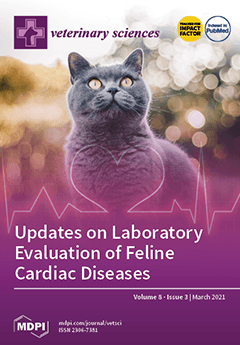Saccharomyces cerevisiae is a yeast strain often used to improve the feed quality of ruminants. However,
S. cerevisiae has limited capacity to provide biomass when inoculated with carbon sources and a low ability to produce cellulase enzymes. Here, we hypothesized that yeast in the rumen produces a large amount of biomass and could release cellulase enzymes to break down fiber content. Therefore, the aim of this study was to screen, isolate and identify yeast from the rumen fluids of Holstein Friesian steers and measure the efficiency of biomass production and cellulase activity. A fermentation medium containing sugarcane molasses as a carbon source and urea as a nitrogen source was optimized. Two fistulated–crossbred Holstein Friesian steers averaging 350 ± 20 kg body weight were used to screen and isolate the ruminal yeast. Two experiments were designed: First, a 12 × 3 × 3 factorial was used in a completely randomized design to determine biomass and carboxymethyl cellulase activity. Factor A was the isolated yeast and
S. cerevisiae. Factor B was sugarcane molasses (M) concentration. Factor C was urea (U) concentration. In the second experiment, potential yeasts were selected, identified, and analyzed for 7 × 4 factorial use in a completely randomized design. Factor A was the incubation times. Factor B was the isolated yeast strains, including codes H-Khon Kaen University (KKU) 20 (as
P. kudriavzevii-KKU20), I-KKU20 (
C. tropicalis-KKU20), and C-KKU20 (as
Galactomyces sp.-KKU20). Isolation was imposed under aerobic conditions, resulting in a total of 11 different colonies. Two appearances of colonies including asymmetric colonies of isolated yeast (indicated as A, B, C, E, and J) and ovoid colonies (coded as D, F, G, H, I, and K) were noted. Isolated yeast from the rumen capable of providing a high amount of biomass when inoculant consisted of the molasses 15% + urea 3% (M15 + U3), molasses 25% + urea 1% (M25 + U1), molasses 25% + urea 3% (M25 + U3), and molasses 25% + urea 5% (M25 + U5) when compared to the other media solution (
p < 0.01). In addition, 11 isolated biomass-producing yeasts were found in the media solution of M25 + U1. There were 4 isolates cellulase producing yeasts discovered in the media solution of M25 + U1 and M25 + U5 whereas molasses 5% + urea 1% (M5 + U1), molasses 5% + urea 3% (M5 + U3), molasses 5% + urea 5% (M5 + U5), molasses 15% + urea 1% (M15 + U1), molasses 15% + urea 3% (M5 + U3), and M25 + U3 were found with 2, 3, 1, 2, 1, and 2 isolates, respectively. Ruminal yeast strains H-KKU20, I-KKU20, and C-KKU20 were selected for their ability to produce biomass. Identification of isolates H-KKU20 and I-KKU20 revealed that those isolates belonged to
Pichia kudriavzevii-KKU20 and
Candida tropicalis-KKU20 while C-KKU20 was identified as
Galactomyces sp.-KKU20. Two strains provided maximum cell growth:
P. kudriavzevii-KKU20 (9.78 and 10.02 Log cell/mL) and
C. tropicalis-KKU20 (9.53 and 9.6 Log cells/mL) at 60 and 72 h of incubation time, respectively. The highest ethanol production was observed in
S. cerevisiae at 76.4, 77.8, 78.5, and 78.6 g/L at 36, 48, 60, and 72 h of incubation time, respectively (
p < 0.01). The
P. kudriavzevii-KKU20 yielded the least reducing sugar at about 30.6 and 29.8 g/L at 60 and 72 h of incubation time, respectively. The screening and isolation of yeasts from rumen fluids resulted in 11 different yeasts being obtained. The potential yeasts discovered in the rumen fluid of cattle were
Pichia kudriavzevii-KKU20,
Candida tropicalis-KKU20, and
Galactomyces sp.-KKU20.
P. kudriavzevii-KKU20 had higher results than the other yeasts in terms of biomass production, cellulase enzyme activity, and cell number.
Full article






